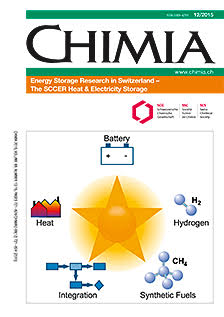Evaluation of Metal Phosphide Nanocrystals as Anode Materials for Na-ion Batteries
DOI:
https://doi.org/10.2533/chimia.2015.724Keywords:
Anode materials, Li-ion batteries, Na-ion batteries, Nanocrystals, SynthesisAbstract
Sodium-ion batteries (SIBs) are potential low-cost alternatives to lithium-ion batteries (LIBs) because of the much greater natural abundance of sodium salts. However, developing high-performance electrode materials for SIBs is a challenging task, especially due to the ?50% larger ionic radius of the Na+ ion compared to Li+, leading to vastly different electrochemical behavior. Metal phosphides such as FeP, CoP, NiP2, and CuP2 remain unexplored as electrode materials for SIBs, despite their high theoretical charge storage capacities of 900–1300 mAh g–1. Here we report on the synthesis of metal phosphide nanocrystals (NCs) and discuss their electrochemical properties as anode materials for SIBs, as well as for LIBs. We also compare the electrochemical characteristics of phosphides with their corresponding sulfides, using the environmentally benign iron compounds, FeP and FeS2, as a case study. We show that despite the appealing initial charge storage capacities of up to 1200 mAh g–1, enabled by effective nanosizing of the active electrode materials, further work toward optimization of the electrode/electrolyte pair is needed to improve the electrochemical performance upon cycling.Downloads
Published
2015-12-16
Issue
Section
Scientific Articles
License
Copyright (c) 2015 Swiss Chemical Society

This work is licensed under a Creative Commons Attribution-NonCommercial 4.0 International License.
How to Cite
[1]
Chimia 2015, 69, 724, DOI: 10.2533/chimia.2015.724.







